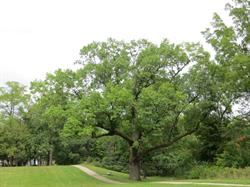 The urban and community forest is a defining and valued characteristic of the city of Ann Arbor, which residents affectionately call "Tree Town,” helping make it a desirable place to live, work and play. It is made up of the trees, shrubs and woody vegetation
growing along city streets; in public parks; and on institutional and private property. The urban forest provides many environmental, economic and social benefits to the community, including reducing stormwater runoff, improving water and air quality, moderating summer temperatures, lowering utility costs, improving quality of life and beautifying the city.
The urban and community forest is a defining and valued characteristic of the city of Ann Arbor, which residents affectionately call "Tree Town,” helping make it a desirable place to live, work and play. It is made up of the trees, shrubs and woody vegetation
growing along city streets; in public parks; and on institutional and private property. The urban forest provides many environmental, economic and social benefits to the community, including reducing stormwater runoff, improving water and air quality, moderating summer temperatures, lowering utility costs, improving quality of life and beautifying the city.
Learn more in the Urban and Community Forest Management plan (PDF).
Tree inventory
Ann Arbor takes advantage of an
online mapping tool that allows staff and residents alike to see the location and species of each city maintained tree within the City of Ann Arbor. Users can see this map on any computer or mobile device with internet access.
Urban tree canopy assessment
This
assessment (4.9 MB PDF) was part of an effort between the City of Ann Arbor, Michigan, the Michigan Department of Natural Resources, and AMEC Earth and Environmental, Inc. (AMEC), with funding assistance from the U.S. Forest Service. The objective was to
map and assess the existing and possible Urban Tree Canopy (UTC) in Ann Arbor and help prioritize street tree planting opportunities.
Cool calculator
Estimate the benefits of trees around your home using the National Tree Benefit Calculator -- type in your zip code, tree species and tree diameter.
iTree Eco analysis
In 2012, the city partnered with Davey Resource Group and the Michigan Department of Natural Resources with funding from the USDA Forest Service Urban and Community Forestry program to conduct an i-Tree Eco Analysis in Ann Arbor. The
iTree Eco Analysis
(1.45MB PDF) calculated the benefits that Ann Arbor's urban forest, both public and private trees, provides to the City. The analysis estimates that Ann Arbor has over 1.45 million trees; these trees remove 405/tons of pollution per year which is equivalent to the pollution produced by 358,000 automobiles annually.
How much does the community benefit from city-owned public trees?
Replacement Value
Ann Arbor's inventoried trees: 51,806
Estimated replacement value of Ann Arbor's inventoried trees: $92 Million
The urban forest provides many benefits. Sustained planting and maintenance efforts have led to an increase in the number of large trees (those reaching maturity) and small trees representing newly planted trees. Some of the benefits provided by these trees are detailed below.
Cleaner water
5.7 million gallons of annual rainfall intercepted
Annual Value of all Ann Arbor Public Trees: $52,487
Stormwater run-off is the most prevalent water quality problem in the nation. Trees in the urban environment decrease the quantity of stormwater run-off and improve the quality of run-off that eventually reaches local lakes, streams, and reservoirs.
The urban forest canopy, along with tree branches, bark, and mosses, captures and stores precipitation, delaying the onset of peak flows and reducing the total amount of run-off that reaches urban waterways via the storm drain system.
Trees slow down stormwater run-off and promote groundwater infiltration.
Trees take up water through their root systems and release it to the atmosphere through evapotranspiration, facilitating greater water storage potential in soils and increasing the amount of time before rainfall becomes run-off.
Tree roots take up nutrients and potentially harmful chemicals from stormwater run-off. Pollutants are filtered out as water moves through the ground.
Healthier air
24,000 pounds of annual air pollutants removed
Value of all Ann Arbor Public Trees: $89,706
Air pollution is a serious health threat that causes asthma, coughing, headaches, respiratory and heart disease, and cancer. The urban forest mitigates the health effects of pollution by:
Absorbing pollutants like ozone, nitrogen dioxide and sulfur dioxide through leaves
Intercepting particulate matter like dust, ash and smoke
Releasing oxygen through photosynthesis
Lowering air temperatures, reducing the production of ozone
Reducing energy use and subsequent pollutant emissions from power plants
Reduced carbon dioxide levels
862,000 pounds of annual CO2 sequestered
Value of all Ann Arbor Public Trees: $74,884
Carbon capture is the process of capturing carbon dioxide formed during power generation and industrial processes.
Carbon storage
65,832,000 pounds of CO2 stored
Value of all Ann Arbor Public Trees: $5,613,781
Trees sequester, or lock up, carbon in roots, trunks, branches, and leaves while growing, and in wood products after harvest so that it is not emitted into the atmosphere.
Lower energy costs
Trees modify and conserve building energy use in three principle ways:
Shading reduces the amount of heat absorbed and stored by buildings.
Evapotranspiration converts liquid water to water vapor and cools the air by using solar energy that would otherwise result in heating of the air.
Tree canopies slow down winds thereby reducing the amount of heat lost from a home, especially where conductivity is high (e.g., glass windows).
Strategically placed trees can increase home energy efficiency. In summer, trees shading east and west walls keep buildings cooler. In winter, allowing the sun to strike the southern side of a building can warm interior spaces. If southern walls are shaded by dense evergreen trees there may be a resultant increase in winter heating costs.
Higher property values
Research shows homebuyers will pay more for a property with mature trees than for a property with few or no trees. This analysis is based on the tree's leaf surface area, and the property value benefit will increase as the tree grows.
